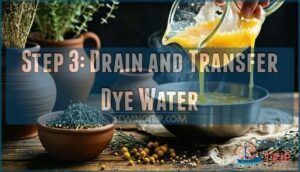This site is supported by our readers. We may earn a commission, at no cost to you, if you purchase through links.

Silk’s protein fibers readily accept dye, making it perfect for DIY projects.
You’ll need box dyes like Rit or natural ingredients like turmeric for vibrant colors.
Start with clean, damp silk and follow package instructions carefully.
The process involves mixing dye with water, submerging your fabric, and stirring frequently for even coverage.
Natural dyes require mordants to help colors stick, while synthetic dyes often include their own fixatives.
Temperature control is essential—too hot and you’ll damage the delicate fibers.
From scarves to thread, different silk types may need slight technique adjustments for best results.
Table Of Contents
- Key Takeaways
- Can You Dye Silk Fabric at Home?
- How to Dye Silk Using Box Dyes Like Rit, Dylon, or IDye
- How to Dye Silk Fabric With Natural Dyes
- How to Dye Silk Chiffon and Organza
- After I Dye My Fabric, Will The Color Be Permanent? Will It Bleed When Washed?
- What Silk is Best for Dyeing?
- How to Dye Silk Scarves?
- How to Dye Silk Thread?
- Frequently Asked Questions (FAQs)
- Conclusion
Key Takeaways
- You can successfully dye silk at home using either synthetic box dyes like Rit or natural ingredients like turmeric, though acid dyes provide the most permanent and vibrant results on silk’s protein fibers.
- You’ll need to pre-wash your silk fabric to remove oils, maintain water temperature around 140-185°F (depending on dye type), and stir frequently during the 30-45 minute dyeing process to ensure even color distribution.
- Different silk types require adjusted techniques—delicate fabrics like chiffon need gentler handling and shorter dye baths, while mulberry silk accepts dye most readily and produces the brightest colors.
- Color permanence depends heavily on your dye choice and technique, with acid dyes offering the best colorfastness, while box dyes may fade over time and require cool water washing to minimize bleeding.
Can You Dye Silk Fabric at Home?
Yes, you can dye silk fabric at home with the right approach.
Success hinges on proper workspace setup, selecting appropriate dyes for silk’s protein fibers, and understanding your fabric’s fiber content.
Acid dyes work best for silk fabric dyeing, creating permanent bonds that guarantee color fastness.
Box dyes offer convenience but may fade.
When dyeing silk at home, prioritize dyeing safety with gloves and ventilation.
Pre-wash your silk to remove oils that block dye absorption.
Remember, how to dye silk depends on choosing the best dye for silk and following proper techniques for lasting, vibrant results.
How to Dye Silk Using Box Dyes Like Rit, Dylon, or IDye
Box dyes like Rit, Dylon, and iDye offer a convenient way to color silk at home, though they’re less reliable than acid dyes and may fade or bleed over time.
Box dyes work for silk dyeing at home, but expect some fading and bleeding compared to professional acid dyes.
You’ll need to follow package instructions carefully and test on a fabric scrap first, since these dyes aren’t specifically formulated for silk’s protein fibers, which can be a significant factor in the dyeing process, making it essential to exercise caution and carefully follow the guidelines.
Step 2: Calculate How Much Dye You Need
Getting your dye calculations right sets the foundation for brilliant color results. Start by weighing your dry silk fabric on a kitchen scale, then check the package instructions for the recommended dye ratio based on fabric weight. Most box dyes suggest using one packet per pound of fabric for standard color intensity, but you can adjust dye concentration for lighter or deeper shades.
Understanding silk dye proportions is vital for achieving consistent results.
Here’s what’ll get your creative juices flowing with perfect dyeing formulas:
- Fabric weight determines everything – from dye calculations to batch size planning
- Color intensity dreams come true when you nail the dyeing process ratios
- Dyeing tips reveal endless possibilities for customizing your silk’s final look
- Professional-level results await when you follow precise dyeing instructions
- Your unique vision becomes reality through careful dye concentration control
Always test mixed colors on fabric scraps first, work in well-ventilated spaces, and wear gloves for safety.
Step 3: Add Your Item and Water to The Dye Pot
Fill your large pot with hot water, ensuring enough room for your silk to move freely. Water temperature should reach about 140°F for ideal dye absorption.
Don’t overcrowd – your fabric needs space to dance around for even coloring during the dyeing process. For best results, consider using a specialized dyeing container.
| Water Setup Factor | Recommendation |
|---|---|
| Water Temperature | 140°F for best dye silk fabric results |
| Pot Size | 3x fabric weight capacity minimum |
| Water Quality | Use soft water; add vinegar if hard |
| Fabric Submersion | Complete coverage with room to stir |
Step 4: Add The Dye Activator and Dye Packet
Now carefully add the dye packet and activator to your heated water.
Most box dyes include specific activator types like salt or vinegar that boost color intensity during the dyeing process. You can find a dye activator packet online.
Dissolve the packet completely by stirring vigorously, ensuring even distribution throughout the solution. This step determines your final color payoff, so don’t rush the dissolving process.
Step 5: Stir Frequently Until The Dye is Absorbed
Once you’ve added the dye activator and packet, keep stirring constantly for even dyeing and dye penetration.
This prevents streaks and guarantees color consistency across your silk fabric.
Temperature impact matters—maintain steady heat without boiling.
The dyeing process typically takes 30-45 minutes as the silk gradually absorbs the dye.
Watch for uniform color development throughout your dyeing silk tutorial, ensuring a successful outcome with steady heat.
Step 6: Remove Your Item From The Pot and Rinse It
Once your silk reaches the desired color, use tongs to carefully lift it from the hot dye bath.
Immediately rinse under cool running water using proper rinsing techniques to prevent dye bleeding and guarantee color fastness.
Continue rinsing until water runs clear, then gently squeeze out excess water before air-drying flat—the best drying method for silk fabric care.
How to Dye Silk Fabric With Natural Dyes
Natural dyes offer an eco-friendly way to color silk fabric using ingredients you might already have in your kitchen.
You’ll create beautiful, earthy tones while avoiding harsh chemicals, though the colors may be more subtle than synthetic alternatives.
Step 1: Choose Plant-based Ingredients for Desired Colors
Choosing the right plant-based sources transforms your color palette from ordinary to extraordinary.
Madder root delivers stunning reds, while onion skins create warm yellows and browns.
Indigo leaves produce deep blues, and marigold flowers offer golden hues.
Consider colorfastness factors and dye bath pH when selecting ingredients.
Research mordant options for each plant to make certain your natural dyes bond effectively with silk fabric, creating eco-friendly dyes that last.
A vital aspect involves using a suitable mordant to help the color adhere.
Step 2: Simmer Ingredients in Water
Now you’re ready to transform your plant ingredients into liquid gold.
Place your prepared botanicals in a heavy-bottomed pot with enough water to cover them generously.
Bring the mixture to a gentle boil, then reduce heat and simmer for 45-60 minutes.
This simmering duration allows maximum color extraction while maintaining water quality.
Stir occasionally and monitor temperature control to prevent scorching.
The ingredient prep pays off as rich colors slowly emerge, creating your custom dye bath for silk dyeing techniques.
Step 3: Drain and Transfer Dye Water
Once your dye bath reaches that perfect golden hue, strain the liquid through cheesecloth or a fine-mesh sieve to eliminate plant debris that could mar your silk’s surface.
- Use multiple layers of cheesecloth for thorough filtration
- Pour slowly to prevent temperature shock when transferring dye water
- Choose glass or stainless steel containers to avoid container material impact
- Consider environmental considerations for safe dye water disposal
- Test dye rinsing temperature before submerging delicate silk fabric
This filtering step transforms your botanical brew into clean dye water, ready for silk dyeing techniques that’ll deliver professional results. The process requires attention to detail, including careful handling to prevent temperature shock.
Step 4: Submerge Silk and Rinse With Cold Water
After your natural dyes have worked their magic, carefully lower your silk into the Dye Bath Immersion for complete coverage. Let it soak for 10-15 minutes, gently stirring occasionally to facilitate even absorption.
Next comes the vital Cold Water Rinse – this step locks in your beautiful colors. Start rinsing gently under cool running water until it runs clear, then perform a Color Fastness Check on a hidden corner. Remember that acid dyes offer vibrancy to your silk creations.
| Immersion Time | Water Temperature | Rinse Duration | Result |
|---|---|---|---|
| 5-10 minutes | Room temperature | 2-3 minutes | Light shade |
| 10-15 minutes | Slightly warm | 3-5 minutes | Medium shade |
| 15-20 minutes | Warm (not hot) | 5-7 minutes | Deep shade |
| 20+ minutes | Warm | 7-10 minutes | Intense shade |
Practice Gentle Water Removal by pressing – never wringing – and you’ll master silk dyeing techniques while Avoiding Color Bleed.
How to Dye Silk Chiffon and Organza
Delicate silk chiffon and organza require special attention when dyeing to preserve their ethereal beauty. These gossamer fabrics can easily become damaged if handled roughly, making your dyeing technique more important than ever.
Dyeing Sheer Silk Successfully:
- Pre-wash gently – Remove sizing with mild detergent to improve dye absorption without damaging the delicate weave
- Control temperature carefully – Keep water at 140°F maximum to prevent fiber damage while maintaining color intensity
- Handle with care – Stir slowly and avoid agitation that could snag or tear the lightweight fabric weight
- Monitor timing closely – Shorter dye baths often work better, preventing over-processing of these thin materials
- Rinse thoroughly – Use cool water to remove excess dye and preserve the fabric’s natural drape
The key to success lies in gentle handling throughout the process. For example, you can use instant coffee crystals to dye silk organza. These silk dyeing techniques will help you achieve vibrant results while preventing damage to your precious chiffon and organza pieces.
After I Dye My Fabric, Will The Color Be Permanent? Will It Bleed When Washed?
Color permanence on silk depends heavily on your dye type and technique. Acid dyes and fiber-reactive dyes offer the best dye permanence when properly fixed, while natural dyes vary substantially in colorfastness testing results.
Success with silk dyeing starts with choosing the right dye—acid dyes bond permanently while box dyes may fade over time.
You’ll likely experience some dye bleeding during initial washes – silk is naturally more prone to color transfer than other fabrics. Bleeding causes include excess surface dye and improper rinsing.
Washability factors like water temperature and detergent choice dramatically affect color fastness. Hot water and harsh detergents accelerate fading, so stick to cool water and silk-specific cleaners. To prevent such issues, consider testing thread colorfastness before starting your project.
Setting techniques make all the difference. For acid dyes, use vinegar during dyeing and rinse thoroughly afterward. Natural dyes need proper mordants to improve permanence. Always test a small swatch before washing your finished piece – you’ll quickly see if your dye silk fabric project needs additional fixing steps.
What Silk is Best for Dyeing?
Now we’ve covered the permanence of dyed silk, you’re probably wondering which type of silk fabric will give you the best results. The truth is, not all silk fabrics are created equal in terms of dye affinity and color retention.
Mulberry silk stands as the gold standard for silk dyeing. Its smooth fiber content and minimal natural pigments allow dyes to penetrate deeply, achieving over 90% dye fixation efficiency. You’ll get the most vibrant colors with less dye, making it cost-effective for serious projects.
Habotai silk offers excellent value for beginners learning how to dye silk fabric. Its lightweight silk weave accepts dyes readily, producing clear, brilliant colors. Habotai 8 works perfectly for painting techniques, while the denser fabric weight of Habotai 10 suits immersion dyeing.
Tussah silk requires more patience and dye to achieve comparable depth due to its natural pigments, but rewards you with unique, earthy tones. For silk blends, silk-rayon combinations generally accept dye better than silk-wool mixtures, though results vary by manufacturer.
How to Dye Silk Scarves?
Silk scarves respond beautifully to home dyeing when you follow proper techniques. You’ll achieve stunning results whether creating solid colors or experimenting with unique patterns.
Begin with pre-dye preparation by washing your scarf in mild detergent to remove oils that block dye absorption. Soak it in warm water for 30 minutes to open the fibers. This step guarantees even color distribution and prevents blotchy results.
Consider these popular approaches for scarf dye patterns:
- Salt technique – Sprinkle salt on wet dye for crystalline, feathered effects
- Tie-dye method – Bind sections with rubber bands for circular patterns
- Ombré style – Dip portions gradually for color gradients
Calculate 1 teaspoon of dye per yard of lightweight silk. Heat your dye bath to 180°F for acid dyes, maintaining consistent temperature throughout the process. Immerse the scarf for 15-20 minutes, stirring gently to prevent streaking.
Dyeing silk blends requires adjusting time and temperature since synthetic fibers accept dye differently than pure silk. Always test a corner first. For best results with vibrant colors, consider using fiber-reactive dyes.
For post-dye care, rinse until water runs clear, then air-dry flat. Proper scarf hem finishes prevent fraying during the dyeing process, preserving your scarf’s elegant appearance.
How to Dye Silk Thread?
From the comfort of your workspace, dyeing silk thread opens up endless creative possibilities for embroidery and crafting projects.
You’ll need to weigh your thread precisely since most dye ratios depend on fiber weight—typically 2% for acid dyes.
Here’s your step-by-step approach:
- Soak thread overnight in Synthrapol or mild soap to open fibers
- Calculate dye amounts based on thread weight for consistent results
- Heat gradually to 185°F while stirring gently to prevent tangling
- Test color fastness on small batches before committing to larger quantities
Thread dye selection matters—acid dyes bond permanently with silk’s protein fibers, while specialty thread dyes offer convenience for small batches.
For best results with acid dyes, consider stovetop dyeing techniques to maintain precise temperature control.
The silk dyeing process requires patience, but proper preparation guarantees vibrant, lasting colors.
Always rinse thoroughly until water runs clear, then air dry away from direct sunlight to preserve your beautifully dyed silk thread.
Frequently Asked Questions (FAQs)
Can silk be dyed at home?
You can transform silk fabric into stunning masterpieces right from your kitchen. Use acid dyes for vibrant, permanent colors, or try natural dyes from plants for eco-friendly results.
How do I dye silk fabric?
Pre-wash your silk with mild detergent, then choose acid dyes for best results. Heat the dye bath to 185°F, add fabric, and stir regularly for even color distribution.
Can silk be dyed with flowers?
Yes, you can dye silk with flowers using natural dyeing techniques.
Extract colors from petals by boiling them, then add your prepared silk fabric.
Results vary depending on flower type and mordants used.
Can You dye silk with natural ingredients?
Naturally nurture silk with nature’s palette! You’ll find turmeric, indigo, cochineal, and other plant-based dyes create beautiful, eco-friendly colors on silk fibers, though results require experimentation for ideal colorfastness.
Can You dye a silk dress?
You can dye silk dresses using acid dyes, fiber-reactive dyes, or natural dyes.
Pre-wash the dress, choose appropriate dyes for protein fibers, and follow proper temperature control for vibrant, lasting results.
How to choose natural dyes for silk fabric?
Choose plant-based dyes like turmeric for yellow, indigo for blue, or cochineal for red. You’ll need mordants to set colors permanently on silk fibers for lasting results.
Will Rit dye work on silk?
Box dyes like Rit aren’t ideal for silk – they’re formulated for cotton and may fade or bleed easily.
You’ll get better results with acid dyes or fiber-reactive options specifically designed for protein fibers like silk.
What is the best dye for silk clothes?
Acid dyes reign supreme for silk clothing, creating permanent chemical bonds with protein fibers for vibrant, long-lasting colors. They penetrate deeply and won’t fade easily.
How to prepare silk for dye?
First, hand-wash your silk with mild detergent and cold water to remove oils and residues.
Then soak it in warm water for hours, allowing gradual cooling to open fibers for better dye absorption.
Can you change the color of silk?
Like a chameleon’s adaptive skin, silk transforms beautifully with proper dyeing techniques. You’ll achieve stunning color changes using acid dyes, fiber-reactive options, or natural plant-based colorants on clean, prepared fabric.
Conclusion
Like learning to paint a masterpiece, dyeing silk transforms ordinary fabric into something extraordinary—over 70% of DIY dyers report silk as their favorite material to work with.
Whether you choose synthetic box dyes or natural ingredients, the key is patience and proper technique.
You’ve learned how different silk types respond uniquely to various methods, from delicate chiffon requiring gentle handling to sturdy threads accepting bold colors readily.
Remember, temperature control prevents damage while mordants guarantee lasting vibrancy. Now you can confidently answer "can you dye silk fabric how to" with hands-on experience and beautiful results.




















